Motorized scooter
A motorized scooter is a powered stand-up scooter using a small utility internal combustion engine or, more commonly, an electric motor. Classified as a form of micro-mobility,[1] these scooters are generally designed with a large deck in the center on which the rider stands. The first production scooter, the "Sport", was released by Go-Ped in 1985.
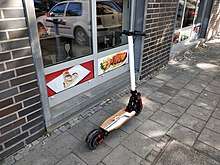
.jpg)
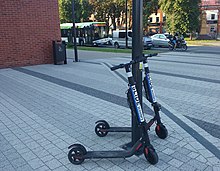
Recently, electric kick scooters (e-Scooters) have grown in popularity with the introduction of scooter-sharing systems that use apps allowing users to rent the scooters by the minute. These have been introduced in large cities such as Denver, Las Vegas, San Francisco, Atlanta, Austin, and Washington, D.C. Other large cities such as Seattle are trying to keep scooter sharing companies out until they can modify laws and roads to make them safer.
History
- 1915: Autoped introduces its stand-up scooter. Pulling back on the handlebar disengaged the clutch and applied the brake. Autoped continued production until 1921; Krupp of Germany built the Autoped under license from 1919 to 1922.[2][3]
- 1986: Go-Ped introduces the first production stand-up scooters, the "Roadster" and the "Sport".
- May 2001: Go-Ped introduces the first full suspension stand-up electric scooter, the "Hoverboard".
- 2004: Evo Powerboards introduces the first scooter with a two-speed transmission, the "2x".
- November 2009: Go-Ped introduces its first completely propane-powered scooter and go-kart, the "GSR Pro-Ped" and the "GSR Pro-Quad".
- 2013-2014: Light electric folding scooters powered by lithium batteries and brushless hub motors become available.
- 2018: Dockless scooter-sharing systems are rolled out in major cities, largely as expansions of bike-sharing systems.[4]
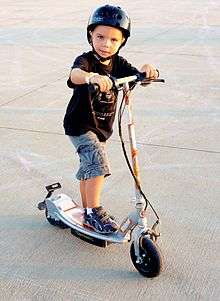 A child on a smaller electric scooter
A child on a smaller electric scooter
Electric
Electric kick scooters have generally surpassed gas-engined scooters in popularity since 2000.[5] They usually have two hard small wheels, with a foldable chassis, usually aluminum. Some kick scooters have three or four wheels, or are made of plastic, or are large, or do not fold. High performance trickster scooters made for adults have a much larger front wheel. Electric kick scooters differ from mobility scooters in that they also allow human propulsion, and have no gears. Range typically varies from 5 to 50 km (3 to 31 mi), and maximum speed is around 30 km/h (19 mph).[6][7]
In 2017, some bicycle-sharing companies such as Lime, and some scooter-only companies, like Bird, began offering dockless electric kick scooter sharing services. This segment of the micro-mobility market made large inroads in 2018, with numerous dockless electric scooters appearing in major cities worldwide,[8] sometimes in controversial and contentious unsanctioned roll-outs, such as in San Francisco.[9] In the meanwhile, it becomes more important for electric kick scooter riders to understand the rules when they are on the road.[10]
Overview
Usage
Motorized kick scooters are used in law enforcement, security patrolling[11][12] and leisure. New ride-sharing systems have made electric scooters easily accessible. They are popular in urban areas and are used as an alternative to bicycling or walking. Ride sharing companies first started dropping these scooters off in large US cities in 2018, and the need for short distance easy access transportation in many cities has meant that they have become increasingly popular with more and more companies looking to join the market.[13]
Health and safety
Electric scooters can pose as an environmentally friendly alternative personal mode of transportation that has appeal in urban settings and for short distances. However, they are not exempt from the vulnerabilities users may encounter in road traffic injuries similar to exposures pedestrians and bicyclists have shared the roads.[14] For example, Israel has seen over 120,000 imports of e-bike and e-scooters over a two-year period, but due to poor cycling infrastructure, cyclists are often forced onto pedestrian sidewalks, and pedestrians use bike lanes and thus increase the risk of traffic collision.[15]
As availability and demand for electric scooters increases alongside often powerful motors with capacities to reach up to 50 miles per hour, the number of traffic accident cases has also increased. Israel witnessed a six-fold increase of e-bike and e-scooter accidents over a span of three years, and China found a four-fold increase in injury rate and a six-fold increase in mortality rates.[15] However, significant gaps remain in the knowledge about the safety measures and impact of electric scooters.
As electric scooters become more popular in urban and high traffic settings, user safety poses a major concern alongside other health risks for drivers, pedestrians, cyclists and other vulnerable groups such as the elderly and children sharing the road. A study conducted in China assessed risky behaviors of e-bike, e-scooter, and bicycle riders at crossing signalized intersections and found three different types of risky behaviors including stopping beyond the stop line, riding in motor lanes, and riding against traffic.[16]
The same study found that those riding e-scooters are more likely to engage in risky behaviors. In specific, e-scooter riders were more likely to ride in motor lanes and ride against the flow of traffic through there is high variability in the types of accidents that occur and can vary based on time of day.[16] Understanding the health impacts of electric scooters should be considered when developing standards and policies for these new but prevalent modes of transportation. For example, policymakers should highly consider whether electric bicycles and electric scooters belong in bicycle lanes, car lanes, or on the roadways at all. Underreporting poses as additional gaps in knowledge, as minor crashes, for example, tend to be underreported and thus unaccounted for in overall electric scooter injury prevalence [17] and there exist gaps in research on injuries related to electric scooters.[14] Scooter-sharing systems such as Lime or Bird include safety precautions on the scooters themselves, such as: "helmet required, license required, no riding on sidewalks, no double riding, 18+ years old". Apps used to unlock and rent the scooters will also have safety reminders and ask the riders to abide by local laws while using them. However, these recommendations are not always followed, and the difference in laws between cities and states makes regulation difficult.
Accidents can be fatal.[18]
Legality
Australia
In Queensland, the laws around the use of electric scooters and other personal mobility devices are made and enforced by the state government.[19][20]
While some local governments in Queensland have not allowed Lime scooter trials, Brisbane City Council is currently undertaking a Lime Scooter trial and has invited tenders for two scooter contracts in the city.
In the ACT, the framework for personal mobility devices was amended to include e-scooters and other similar devices from 20 December 2019, permitting use on footpaths, shared paths, bicycle paths and the bicycle side of separated paths. [21]
Austria
Electric vehicles with a power up to 600W and a speed up to 25 km/h are considered as bicycles.[22][23]
Belgium
Belgium's traffic rules were updated on 1 June 2019 to be in line with the European Commission guidelines formed in 2016.[24] It is now legal to ride electronic motorised scooters on public roads with the speed limited to 25 km/h, mirroring e-bikes. Additionally, they have concluded that protective gear and insurance is not required by law. 15 years old is the legal age at which electric scooters can be driven in Belgium.[25]
France
Currently France only allows scooters on sidewalks if they have a maximum speed of 6 km/h. Those traveling at up to 25 km/h are relegated to bike lanes. Legislators are considering a new law that would force users of scooters going faster than 25 km/h to have a type A1 license — the same as for small motorcycles. The legal framework is very blurry and does not define where scooters may or may not be driven or parked. Paris Deputy Mayor Christophe Najdovski is lobbying Transport Minister Elisabeth Borne for a clearer framework that would give municipalities the power to tighten the rules on how permits are issued and how authorizations are given to deploy a fleet of electric scooters to operators.[26]
French daily newspaper Le Parisien found that in 2017, electric scooters and roller skates combined caused 284 injuries and five deaths in France, a 23 percent increase on the previous year.[27] The perception of electric scooters is that they are fast, silent and therefore dangerous, causing many accidents, and the need to legislate is urgent.[26]
Germany
In April 2019, the "electric propulsion vehicles without seats" and mono-wheels were added to the regulatory list of vehicles allowed to circulate in the streets. However, the list has yet to be submitted to the upper house of Parliament for entry into force.
The regulation makes a distinction between vehicles restricted to 12 km/hour, authorized to users aged from 12 years up and which may circulate on sidewalks, and those restricted to 20 km/hour, restricted to cycle paths and users over 14 years old.[28]
Ireland
The use of electric scooters and mono-wheels have exploded in Irish urban areas in recent years, with estimated more than 2,000 electric scooters regularly traveling the roads of Dublin.[29]
Under existing road traffic legislation, the use of an electric scooter on public roads is not permitted. According to the Road Traffic Act 1961, all electric scooters are considered to be "mechanically propelled vehicles". Anyone using a mechanically propelled vehicle in a public place must have insurance, road tax, and a driving license. However, it is currently not possible to tax or insure e-scooters or electric skateboards.
In March 2019, electric scooter owners started reporting that the Irish police force, the Garda Síochána, had begun regularly seizing electric scooters on the grounds that the owner did not have insurance.[30] This was despite a Freedom of Information request detailing that the Garda website displayed incorrect information to the public, detailing that electric scooters requiring human power to start would not be considered mechanically propelled vehicles and, as such, would fall outside the remit requiring insurance.[31] The owner groups, such as eScoot.ie, have been publicly vocal, attracting media attention and urging electric scooter owners to sign a petition for lawmakers to legalize the public use of "electric rideables" in Ireland.[32] Under growing pressure, the Minister for Transport Shane Ross asked the Road Safety Authority to research how e-scooters are regulated in other countries, particularly other EU member states. A decision is to be taken on whether or not to amend existing legislation.[33] In August 2019 the RSA submitted a report on the use of electric scooters to the Minister for Transport Shane Ross. The report is broadly in favour of e-scooters, however a number of significant safety concerns were raised. The Minister have announced a two-month public consultation starting on 1 September 2019.[34] The main areas of the consultation cover what personal protective equipment should be used, what training should be provided, what safety or certification standards devices should meet, what age restrictions should apply and where the devices can be used publicly.
Netherlands
The use of electric scooters remains illegal after a fatal electric cart incident in 2018.[35]
New Zealand
Electric scooters in New Zealand are classed as a 'Low-powered vehicle that does not require registration', provided that the output power is under 300 watts.[36] They can therefore be ridden on footpaths, roads and separated cycleways. They cannot be ridden on paint-defined cycleways on the road. Helmets are not legally required, but recommended.
Norway
In Norway, Electric scooters are classed as bicycles, and can therefore be ridden on footpaths, roads and separated cycleways as well as paint-defined cycleways on the road. Maximum speed is restricted to 20km/h. Maximum weight of the scooter, including the battery, must not exceed 70kg. Maximum width must not exceed 85cm and maximum length is 120cm. There is no age restriction or requirement to wear a helmet.[37]
Poland
Following a court case, a new provision of the Road Traffic Act came into force as of 21 April 2019, whereby an electric scooter falls under the definition of a moped[38] (power up to 4 kW, max speed 45 km/h). Therefore, such vehicles are not allowed to ride on the sidewalks as well as bicycle lanes. However, due to the lack of homologation, it is not possible to register electric scooter as a road vehicle, which makes it illegal for the use on the road. The legislators are now working on changes to the law to introduce the definition of the Personal Transport Device, which would allow electric scooters to be used on the sidewalks and bicycle lanes.[39]
Singapore
Electric scooters in Singapore are categorized as Personal Mobility Devices (PMD), and as such, are subjected to the Land Transport Authority's regulations. All electric scooter owners are required to register their devices with the Land Transport Authority and affix the registration number on their scooter. Scooters that are not registered by 1 July 2019 will have their devices seized by the authorities and the offender would be liable for punishment.
Scooters sold in Singapore have to comply with a strict set of regulations; maximum speed of 25 km/h, must not exceed 70 cm in width & must not weigh more than 20 kg. Retailers are allowed to sell non-compliant electric scooters however they have to indicate clearly that they can only be used on private property or for use overseas.
Unlike electric bicycles, electric scooters can only be ridden on sidewalks and cycling paths. They are not allowed to be ridden on public roads.
Spain
Scooters' recurring role in traffic accidents has led to a regulatory pushback in Spain. There have been reported 273 accidents, three of which were fatal in 2018. Spanish legislators are working on a regulation banning scooters from pavements and limiting their speed to 25 km/h.[26]
The first ever person hit by electric scooter died in Spain in August 2019. A 92-year-old woman fell and struck her head to the pavement when an electric scooter hit her, travelling at less than 10 km/h.[40]
United Kingdom
Privately owned escooters can only be used on private land: but in some trial areas rental escooters are legal on roads and cycle lanes but not pavements, and riders must be 16 or over and have a driving licence.[41]
On 12 July 2019 the first UK fatality involving an e-scooter occurred. A 35-year-old YouTube personality, Emily Hartridge, was killed in Battersea, London in a collision on a roundabout with a truck. London's cycling commissioner said that "new regulations must be put forward quickly" as e-scooters are "currently not safe – with no restrictions on speeds, no mandatory brakes and lights, and no rules on who can ride them and where".[42]
United States
In many areas in the United States, motorized scooters are not street legal, as they cannot be tagged, titled, insured, and do not meet federal requirements for lights or mirrors. Particular localities may have further ordinances that limit the use of motorized scooters. The top speed of the average motorized scooter is around 20 miles per hour (32 kilometers per hour). Due to their small wheels, motorized scooters are not typically safe for street use as even the smallest bumps can cause an accident.
California requires that a person riding a motorized scooter on a street be 16 years of age or older, have a valid driver's license, be wearing a bicycle helmet, have no passengers, and otherwise follow the same rules of the road the same as cars do. The motorized scooter must have brakes, may not have handlebars raised above the operator's shoulders, and if ridden at night must have a headlight, a taillight, and side reflectors. A motorized scooter may not be operated on sidewalks or on streets if the posted speed limit is over 25 mph (40 km/h) unless in a Class II bicycle lane.[43]
Michigan laws treat motorized scooters similarly to bicycles. They are typically allowed on sidewalks, bike lanes, and roads.[44]
In Washington, D.C., motorized scooters are classified as Personal Mobility Devices, and are therefore not considered motor vehicles. This means there is no inspection, license, insurance, or registration required. Additionally, this means that motorized scooters are allowed on the sidewalks, and helmets are not required.[45]
In Atlanta, motorized scooters are considered Electric Personal Assistive Mobility Devices, meaning they can be used on sidewalks and highways where the speed limit is at most 35 miles per hour, or in the bike lane. The law also specifies that users of Electric Personal Assistive Mobility Devices, including motorized scooter riders, "have the same rights and duties as prescribed for pedestrians".[46]
Scooter sharing companies have rules for operation printed on both the scooter and in the app, which includes instructions to not ride on the sidewalk. Given that the laws regarding motorized scooters vary from state to state, the scooter sharing instructions can differ from the local law.[47]
Mechanics
Wheels and tires
There are two general categories of tires on which stand-up scooters travel—hard tires and air tires. Hard tires are generally 6 inches (150 mm) in diameter and constructed of a hard-plastic insert surrounded by a solid rubber tire. Air tires are most often 10 inches (250 mm) in diameter. They are constructed of a steel or aluminum split rim, an inner tube and rubber tire. Other, less common wheel and tire types include 8 inches (200 mm) and 13 inches (330 mm) air tires.
Transmissions
The most simplistic drive mechanism of stand-up scooters is the "spindle" drive. This drive mechanism puts an extension of the engine's output shaft, the spindle, in direct contact with the rear tire of the scooter. In order to function correctly, the tire must have a clean, dry surface which the spindle will be able to effectively interact with. Scooters with this type of direct transmission can be pull-started with the rear wheel off the ground, or "bump"-started by forcefully pushing the scooter with the rear tire in contact with the ground.
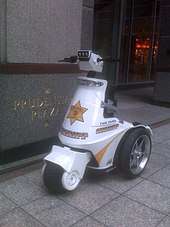
Simple chain reduction drives are also used to transfer energy to the rear wheel from the engine. These generally incorporate a type of centrifugal clutch to allow the engine to idle independently.
Belt reduction drives use the combination of wide flat "cog" belts and pulleys to transfer power to the rear wheel. Like chain drives, belt drives include a centrifugal clutch. Belt drives are more susceptible to breakage in off-road conditions.
Suspension
The suspension systems of stand-up scooters range from simplistic spring based fork systems to the complicated, dampened cam-link and C.I.D.L.I[48] suspension mechanisms or a hybrid combination of wooden deck, coil spring, and dampers.
Brakes
Brake systems of kick scooters can range from Disc Brake system, magnetic brake (used for energy consumption), or the less efficient Hydraulic Brakes, where brakes can be placed on either -or both- the front and back wheel(s). Many newer models of e-scooter also have Kinetic Energy Regeneration System (KERS), which also acts as an E-ABS on many models.
Gallery
 Photo on exhibition in the private scootermuseum, Assisi, Italy
Photo on exhibition in the private scootermuseum, Assisi, Italy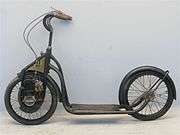 1922 Austro Motorette 82 cc two stroke
1922 Austro Motorette 82 cc two stroke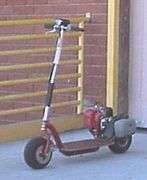 Example of a Go-Ped.
Example of a Go-Ped.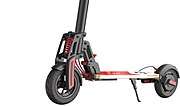 Zukboard City
Zukboard City
Companies
- Unagi Scooters
- Lime (transportation company)
- Razor
- Segway Inc. / Ninebot
- Xiaomi
- Zero
- INOKIM
See also
| Wikimedia Commons has media related to Motorized kick scooters. |
- Scooter-sharing system
- Bicycle-sharing system
- Segway PT
- DrunkLizard
References
- "Micromobility is the future of urban transportation | Deloitte Insights". www2.deloitte.com.
- Wilson, Hugo (1995). "The A-Z of Motorcycles". The Encyclopedia of the Motorcycle. London: Dorling Kindersley. p. 22. ISBN 978-0-7513-0206-6.
- Wilson, Hugo (1995). "The Directory of Motorcycles". The Encyclopedia of the Motorcycle. London: Dorling Kindersley. p. 243. ISBN 978-0-7513-0206-6.
- Robinson, Melia (2018-04-02). "Electric scooters for grown-ups are taking over San Francisco, and tech workers are annoyed". Business Insider. Retrieved 2018-06-03.
- "The History of The Motorized Electric Scooter". February 2010. Retrieved February 28, 2018.
- "It's Too Bad Electric Scooters Are So Lame, Because They May Be the Future". Wired. January 2016. Retrieved December 8, 2017.
- Neil, Dan (September 22, 2015). "The URB-E: An Electric Scooter That's a Thrill to Ride". The Wall Street Journal. Retrieved April 4, 2016.
- Morris, Sarah (2018-09-06). "An Electric Kick-Scooter Sharing Service Is Coming to Melbourne". Broadsheet. Retrieved 2018-09-16.
- Raphelson, Samantha (2018-08-29). "Dockless Scooters Gain Popularity And Scorn Across The U.S." NPR.org. Retrieved 2018-09-16.
- "10 Rules & Etiquettes For Adult Scooter Commuters". Mobility Seeker. 2019-10-26. Retrieved 2020-02-19.
- Kaminer, Ariel (22 October 2010). "To Serve and Protect, Perched on 3 Wheels". The New York Times. Retrieved 15 November 2012.
- "Pentagon Deploys T3 Series Clean Energy, Electric Stand-up Vehicle for Perimeter Security". T3 Motion, Inc. Reuters. 6 January 2011. Archived from the original on 30 January 2011. Retrieved 15 November 2012.
- "The Love of the People Isn't Enough to Keep Shared Electric Scooters Rolling". WIRED. Retrieved 2018-10-26.
- Xu, Jun; Shang, Shi; Yu, Guizhen; Qi, Hongsheng; Wang, Yunpeng; Xu, Shucai (2016-02-01). "Are electric self-balancing scooters safe in vehicle crash accidents?". Accident Analysis & Prevention. 87: 102–116. doi:10.1016/j.aap.2015.10.022. ISSN 0001-4575. PMID 26656151.
- Siman-Tov, Maya; Radomislensky, Irina; Israel Trauma Group; Peleg, Kobi (3 April 2017). "The casualties from electric bike and motorized scooter road accidents". Traffic Injury Prevention. 18 (3): 318–323. doi:10.1080/15389588.2016.1246723. ISSN 1538-957X. PMID 28166412.
- Bai, Lu; Liu, Pan; Guo, Yanyong; Yu, Hao (2015-01-15). "Comparative Analysis of Risky Behaviors of Electric Bicycles at Signalized Intersections". Traffic Injury Prevention. 16 (4): 424–428. doi:10.1080/15389588.2014.952724. ISSN 1538-9588. PMID 25133656.
- Yang, Hongtai; Cherry, Christopher R.; Su, Fan; Ling, Ziwen; Pannell, Zane; Li, Yanlai; Fu, Zhijian (2018-05-25). "Underreporting, crash severity and fault assignment of minor crashes in China - a study based on self-reported surveys". International Journal of Injury Control and Safety Promotion. 26 (1): 30–36. doi:10.1080/17457300.2018.1476382. ISSN 1745-7319. PMID 29798710.
- Stolworthy, Jacob (14 July 2019). "TV presenter and YouTube star Emily Hartridge identified as first person killed in UK riding e-scooter". The Independent. Retrieved 14 July 2019.
- Queensland;, c=AU; o=The State of. "Rules for personal mobility devices | Bicycles, skateboards, foot scooters and similar". www.qld.gov.au. Retrieved 2020-03-07.CS1 maint: extra punctuation (link)
- https://www.qld.gov.au/transport/safety/rules/wheeled%20-devices%20/%20personal-mobility-devices%5B%5D
- Canberra, Access Canberra; PositionTitle=Manager; SectionName=Access Canberra; CorporateName=Access. "Personal mobility device use in the ACT". www.accesscanberra.act.gov.au. Retrieved 2020-01-29.
- "RIS - Straßenverkehrsordnung 1960 § 2 - Bundesrecht konsolidiert, tagesaktuelle Fassung". www.ris.bka.gv.at. Retrieved 2019-06-08.
- "RIS - Kraftfahrgesetz 1967 § 1 - Bundesrecht konsolidiert". www.ris.bka.gv.at. Retrieved 2019-06-08.
- "Scooters - European commission". European Commission. 5 October 2016. Retrieved 15 June 2019.
- "Wetgeving elektrische steps België". www.doorgelicht.be. 1 June 2019. Retrieved 1 June 2019.
- "E-scooters test Europe's old traffic rules". www.politico.eu. 12 January 2019. Retrieved 24 April 2019.
- "Les Accidents de Trottinettes en Forte Hausse". www.leparisien.fr (in French). 11 October 2018. Retrieved 24 April 2019.
- "E-scooters in Germany". www.newmobility.news. 4 April 2019. Retrieved 24 April 2019.
- "Electric scooters: The future of urban transportation?". www.irishtimes.com. 9 March 2019. Retrieved 24 April 2019.
- "Gardaí confiscate electric scooters". www.thetimes.co.uk. 23 April 2019. Retrieved 24 April 2019.
- "Garda Website Showed Incorrect Information About Electric Scooters". www.goosed.ie. 20 January 2020. Retrieved 30 May 2020.
- "Petition to legalize the public use of electric rideables in Ireland". www.escoot.ie. 19 April 2019. Retrieved 24 April 2019.
- "Law means electric scooters are a non-starter on Irish roads". www.irishtimes.com. 9 March 2019. Retrieved 24 April 2019.
- "Public consultation on Personal Powered Transport". www.gov.ie. 1 September 2019. Retrieved 4 September 2019.
- "Four children killed in electric cart". www.bbc.co.uk. 20 September 2018. Retrieved 25 April 2019.
- "Low-powered vehicles". New Zealand Transport Agency. Retrieved 19 February 2020.
- "Small electric vehicles". Statens Vegvesen. Retrieved 31 July 2020.
- "Sąd uznał, że jadący na hulajnodze elektrycznej nie jest pieszym". tvnwarszawa.tvn24.pl (in Polish). Retrieved 24 April 2019.
- "zenia transportu osobistego. Czekaliśmy na odpowiedź resortu i jest". www.prawodrogowe.pl (in Polish). Retrieved 24 April 2019.
- "No jail for man who caused first electric scooter death". CatalanNews. 1 August 2019. Retrieved 4 September 2019.
- Bernal, Natasha (2020-07-01). "Rental e-scooters are now legal. Here's what you need to know". Wired UK. ISSN 1357-0978. Retrieved 2020-07-03.
- "E-scooter crashes spark call for new rules". www.bbc.co.uk. 16 July 2019. Retrieved 23 August 2019.
- "Scooter and Go-Ped Guidelines". Archived from the original on 2011-03-11. Retrieved 2010-05-18.
- "Michigan laws on motorized scooters". detroitgreenways.org. 2018-10-13. Retrieved 2019-01-21.
- "Non-Traditional Motor Vehicles and DC Law | dmv". dmv.dc.gov. Retrieved 2018-10-28.
- "Georgia Code: Low Speed Vehicles | Georgia Department of Public Safety". dps.georgia.gov. Retrieved 2018-10-29.
- "10 Rules & Etiquettes For Adult Scooter Commuters". Mobility Seeker. 2019-10-26. Retrieved 2020-04-20.
- Cantilevered Independent Dynamic Linkless Indespension